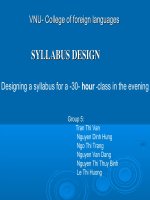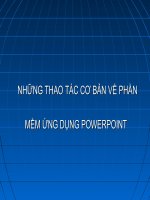thiet ke giao trinh(xin lam)
Bạn đang xem bản rút gọn của tài liệu. Xem và tải ngay bản đầy đủ của tài liệu tại đây (3.99 MB, 33 trang )
VNU- College of foreign languages
VNU- College of foreign languages
Syllabus design
Syllabus design
Designing a syllabus for a -30- hour -class in the evening
Group 5:
Tran Thi Van
Nguyen Dinh Hung
Ngo Thi Trang
Nguyen Van Dang
Nguyen Thi Thuy Binh
Le Thi Huong
Part I: General information about
Part I: General information about
the course
the course
The learners
The learners
The learning
The learning
Course duration
Course duration
Course aims and objectives
Course aims and objectives
1.
1.
General goals of learning:
General goals of learning:
Our course is aimed to:
Our course is aimed to:
to help learners develop key skills in the
to help learners develop key skills in the
correct use of English for reading, writing,
correct use of English for reading, writing,
speaking and listening. There is an emphasis
speaking and listening. There is an emphasis
on communicative activities.
on communicative activities.
to help learners develop a natural and
to help learners develop a natural and
accurate style of English pronunciation.
accurate style of English pronunciation.
to improve learners’ ability to understand and
to improve learners’ ability to understand and
use vocabulary and expression common to
use vocabulary and expression common to
everyday life.
everyday life.
to help learners improve their understanding
to help learners improve their understanding
of key aspects of English grammar,
of key aspects of English grammar,
structures, skills.
structures, skills.
2. Specific objectives:
2. Specific objectives:
This syllabus is designed for a course of
This syllabus is designed for a course of
approximately 30 class hours of instruction and
approximately 30 class hours of instruction and
takes learners from the verb “to be” through
takes learners from the verb “to be” through
present, continuous forms as well as other
present, continuous forms as well as other
basic structures such as subject and object
basic structures such as subject and object
pronouns, this, that, these, those, possessive…
pronouns, this, that, these, those, possessive…
3. Level of English learners
3. Level of English learners
This syllabus is designed for “false” learners.
This syllabus is designed for “false” learners.
Most learners in this course are adult learners.
Most learners in this course are adult learners.
Each group of 5 lessons is followed by a
Each group of 5 lessons is followed by a
planned review lesson which allows students a
planned review lesson which allows students a
chance to review what they have learnt. This
chance to review what they have learnt. This
syllabus can be adapted to fit learners’ needs
syllabus can be adapted to fit learners’ needs
and is presented as a basic on which to build
and is presented as a basic on which to build
an elementary level in ESL English course.
an elementary level in ESL English course.
4. Level of motivation
4. Level of motivation
Intermediate - level
Intermediate - level
“
“
False” learners are typically learners
False” learners are typically learners
who had a few years to learn English
who had a few years to learn English
and are now returning to start learning
and are now returning to start learning
again for a variety of reasons: work, travel,
again for a variety of reasons: work, travel,
hobbies…
hobbies…
1.Teaching situation:
1.Teaching situation:
English is taught with a lot of
English is taught with a lot of
communication activities, mostly worked
communication activities, mostly worked
in pairs or small groups
in pairs or small groups
2.
2.
Number of learners
Number of learners
: 20 students
: 20 students
3. Size
3. Size
: 15 m
: 15 m
2
2
4. Facilities:
4. Facilities:
videos, tapes, cassette
videos, tapes, cassette
players.
players.
5. Administrators’ attitude:
5. Administrators’ attitude:
Administrators should:
Administrators should:
•
promote learners’ achievement
promote learners’ achievement
•
Support and develop a talented staff
Support and develop a talented staff
•
Build a solid organizational structure
Build a solid organizational structure
This course lasts in 5 weeks.
This course lasts in 5 weeks.
Aims
Aims
To prepare learners to communicate in English at a basic
To prepare learners to communicate in English at a basic
level for purposes of travelling, jobs and their lives
level for purposes of travelling, jobs and their lives
Objectives:
Objectives:
By the end of the course learners will be able to:
By the end of the course learners will be able to:
Have a reading vocabulary of 300 common words.
Have a reading vocabulary of 300 common words.
Have a listening vocabulary of 300 common words
Have a listening vocabulary of 300 common words
numbers up to 100
numbers up to 100
Understand simple written descriptions
Understand simple written descriptions
Understand simple questions, statements, greetings.
Understand simple questions, statements, greetings.
Can get the gist if simple conversation in spoken English
Can get the gist if simple conversation in spoken English
Hold a bilingual conversation, speaking English slowly
Hold a bilingual conversation, speaking English slowly
and clearly in simple words
and clearly in simple words
Use and understand appropriate gestures
Use and understand appropriate gestures
Have confidence to initiate conversations in English, be
Have confidence to initiate conversations in English, be
unafraid of making mistakes.
unafraid of making mistakes.
Part II: Syllabus content
Part II: Syllabus content
Time
Time
Topic
Topic
Structures/
Structures/
Vocabularies
Vocabularies
Function
Function
Tasks/
Tasks/
Activities
Activities
Week
Week
1
1
People
People
and
and
places
places
Be
Be
: names and
: names and
countries.
countries.
Be
Be
: personal
: personal
information
information
Pronunciation
Pronunciation
:
:
short forms
short forms
Article
Article
: an and a +
: an and a +
job
job
Pronunciation
Pronunciation
:
:
sentence stress in
sentence stress in
question and
question and
short answer.
short answer.
-Talking about
-Talking about
names, countries and
names, countries and
jobs
jobs
-getting the personal
-getting the personal
information.
information.
-Talking about
-Talking about
names, countries
names, countries
and jobs.
and jobs.
- Scanning the
- Scanning the
personal
personal
information.
information.
- Identify the
- Identify the
article: a ,an
article: a ,an
- Putting the stress
- Putting the stress
in questions and
in questions and
short answers.
short answers.
Time
Time
Topic
Topic
Structures/
Structures/
Vocabularies
Vocabularies
Function
Function
Tasks/
Tasks/
Activities
Activities
Week
Week
2
2
Descript
Descript
ion
ion
Have got/ has got
Have got/ has got
Families
Families
This/ that/ these/
This/ that/ these/
those
those
Pronunciation: this,
Pronunciation: this,
that, these, those
that, these, those
-Describing one’s
-Describing one’s
appearance
appearance
- Talking about
- Talking about
surroundings
surroundings
-Reading and
-Reading and
guessing the
guessing the
meaning of the
meaning of the
words in context
words in context
-Writing
-Writing
description about
description about
your family
your family
-Listening the
-Listening the
conversation
conversation
-Finding out your
-Finding out your
partner’s
partner’s
information.
information.









